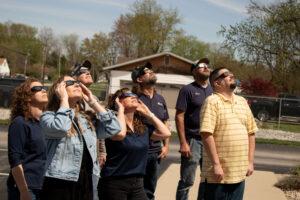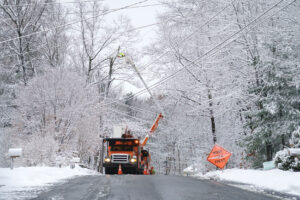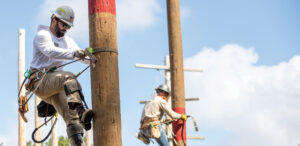
Southern Illinois proved to be a prime spot to watch a solar eclipse, at least in recent history. For the second time in seven years, southern Illinois experienced a total eclipse on April 8. The path of totality cut through the territories of 12 electric cooperatives in Illinois, with half of those covered 100% by the moon’s shadow.
At the center of the two eclipses (the last one in 2017) is the service territory of Egyptian Electric Cooperative Association (EECA). Headquartered in Murphysboro, the co-op witnessed a 4-minute, 7-second eclipse totality this year.
“Southern Illinois was more prepared than in 2017,” said Brooke Guthman, member services manager at EECA. “The amount of outgoing traffic last time was underestimated. So, we wanted to make sure we were ready for this year’s eclipse.”
To prepare, EECA decided to close the office for the afternoon for an all-employee training about co-op policies and procedures, followed by a viewing of the eclipse with their families. Employees were then sent home to try and avoid outgoing traffic congestion. Any phone calls were sent to the Cooperative Response Center, and the co-op’s maintenance lineworkers are always equipped with take-home trucks to help quickly handle issues or outages if needed.
EECA headquarters is located nearly 14 miles away from Carbondale, which was considered the crossroads location between the 2017 and 2024 eclipses. Heavy traffic was anticipated all day. Shortly after 8 p.m., six hours after the eclipse totality, the Illinois Department of Transportation reported on its Facebook page that traffic began to improve throughout the state.
Other Illinois electric cooperative employees viewed the natural phenomenon together as well. For 3 minutes, 32 seconds, employees of Clay Electric Co-operative experienced complete totality at its headquarters in Flora.
“Clay Electric provided solar eclipse viewing glasses to all staff and had a ‘shop day’ for the lineworkers,” said Adam McKnight, member services manager for the co-op. Meaning, the lineworkers were not performing routine line maintenance as they normally would.
“We expected a lot of people out and about. No need to try to drive line trucks around [in all the traffic].”
Similarly, Wayne-White Counties Electric Cooperative, which experienced totality for 4 minutes, 4 seconds at its headquarters in Fairfield, also had an office day so employees wouldn’t have to navigate eclipse traffic. The lineworkers were stationed at the office and outposts with trucks and equipment ready to go in case of any emergencies.
“Otherwise, our office was open as usual and fully staffed,” said Alyssa Parrott, the co-op’s communications specialist. “We had a great day here and definitely enjoyed totality. It was pretty amazing. … Everything went very smoothly, and everyone here got to enjoy the eclipse.”
Other electric co-ops that experienced eclipse totality within their service territories included SouthEastern Illinois Electric, Tri-County Electric, Southern Illinois Electric, Norris Electric, EnerStar Electric, Clinton County Electric, Monroe County Electric, Southwestern Electric and Coles-Moultrie Electric. From Texas to Maine, a total of 115 distribution electric cooperatives experienced totality.
Despite some concern from industry analysts regarding solar power production dropping to zero during totality, no electric cooperative in Illinois reported a loss of electric service because of the eclipse. The next solar eclipse in Illinois will occur in the Chicago area in 2099.








